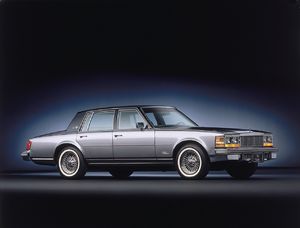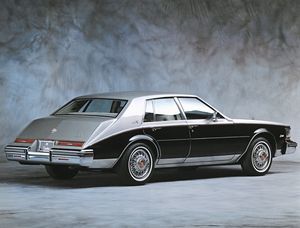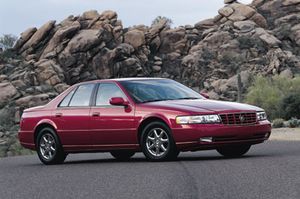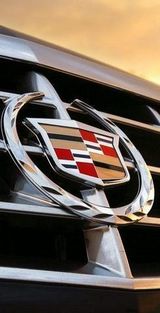.
Cadillac Seville

| |
| Cadillac Seville | |
|---|---|
| Cadillac | |
| Production | 1976-1979 |
| Class | Compact/Intermediate |
| Body Style | 4 Door Sedan |
| Length | 204" |
| Width | 71.8" |
| Height | 54.7" |
| Wheelbase | 114.3" |
| Weight | 3500-3800 lbs |
| Transmission | 3-Speed Automatic, RWD |
| Engine | 5.7L (350 cid) V8 (1976-1979) 5.7L (350 cid) diesel V8 (1978-1979) |
| Power | 105-185 hp |
| Similar | Buick Skylark Chevrolet Nova Oldsmobile Omega//Pontiac Ventura/Phoenix |
| Platform | K |
Using a name that was once an optional trim level on 1956-1960 Cadillac Eldorado models, the Cadillac Seville became a model on its own in mid-1975 as a 1976 model. Though it was largely based on GM's X-body platform (Buick Skylark, Chevrolet Nova, etc), it was differentiated enough to be given its own unique "K" body designation. This new Seville was Cadillac's answer to the the rising popularity of luxury imports in the USA from Europe, such as Mercedes-Benz and BMW. Historically, these imported luxury cars had been cheaper, less luxurious and significantly smaller than Cadillacs, but over time they had evolved, and had become quite luxurious and even more expensive than competing Cadillacs, and yet the market share of these imports continued to climb. It became obvious that the traditional American automotive paradigm of bigger=better was no longer in full effect in the marketplace. So the Seville was to be simultaneously the smallest and the most expensive Cadillac in the line-up, turning Cadillac's traditional marketing and pricing strategy on its head. The Seville would undergo several transformations during its tenure before being replaced by the STS, itself formerly a Euro-inspired option package (Seville Touring Sedan) available on Seville from 1988-2004 in 2005.
Original Pre-Production Concepts
The prototypes pictured above show the various styling directions explored by Cadillac prior to the final version that debuted in 1975. It is interesting to note the direction the design took as it evolved, dropping traditional American luxury car styling cues and body proportions in favor of a more compact, less flamboyant final design. Various names for the proposed vehicle were explored as well. Resurection of the LaSalle moniker was seriously considered, but it was decided that given that LaSalle had historically been used for entry-level sub-Cadillacs in the past, it would create confusion in the marketplace among those who recollected the the context of the moniker's earlier usage.
1st Generation (1976-79)
The Seville debut couldn't have come at a better time, a time when many Americans were clamoring for a luxury car in a smaller, more manageable size than the usual mastodons offered by Cadillac, Lincoln and Chrysler, and as a result, the Seville became an instant hit. It was available with all the usual Cadillac bells and whistles of the day, but an interesting fact about the 1st generation Seville is that Cadillac, in a very bold move, actually priced the base Seville higher than the larger DeVille and Eldorado models - and it still became a huge sales success nonetheless. It was powered by a 185 hp fuel-injected Oldsmobile-built 350 cid V8, becoming the first Cadillac in many decades to be powered by a non-Cadillac engine, but the public obviously didn't care very much. A 3-speed automatic transmission was standard. 1977 models sported a revised grille but were otherwise largely unchanged. Sales remained strong in its sophomore year, and it was evident that Cadillac was definitely on to something with the Seville as it spawned some domestic imitators this year, namely the Lincoln Versailles and, to a lesser extent, the Chrysler LeBaron and Dodge Diplomat.
For 1978, Cadillac treated the Seville to another revised grille and its own uplevel trim package, the Elegante, which added a unique black/silver two-tone exterior paint combination and "perforated-style" leather seats in light grey only. Real wire wheels were also standard as were a host of options. 1978 also became famous (or infamous) for introducing the 105 hp Oldsmobile 350 diesel V8 engine as an option. The diesel at first became a fairly popular option, but quickly gained several reputations for being notoriously unreliable, as well as smelly, noisy, unrefined, slow... and generally just a very unpleasant powerplant. In 1979, Seville Elegantes got another 2-tone color combo (copper shade and a matching leather interior). A limited-edition Gucci trim package also became available, and available only in white, black and medium-brown. This package included many unique Gucci styling touches and badging, and even included a set of Gucci luggage. The gas and diesel 350 V8s were still available. The Seville would be an all-new model for 1980.

|
|||
| Cadillac Seville | |||
|---|---|---|---|
| Cadillac | |||
| Production | 1980-1985 | ||
| Class | Intermediate | ||
| Body Style | 4-Door Sedan | ||
| Length | 204.8" | ||
| Width | 71.2" | ||
| Height | 54.3" | ||
| Wheelbase | 114" | ||
| Weight | 3600-3900 lbs | ||
| Transmission | 3-Speed Automatic, FWD 4-Speed Automatic, FWD | ||
| Engine | 4.1L (250 cid) V8 (1982-1985) 4.1L (252 cid) V6 (1981-1985) 5.7L (350 cid) diesel V8 (1980-1985) 6.0L (368 cid) V8 (1980-1981) 6.0L (368 cid) V8-6-4 (1981) | ||
| Power | 105-140 hp | ||
| Similar | Buick Riviera Cadillac Eldorado Oldsmobile Toronado | ||
| Platform | E | ||
2nd Generation (1980-85)
The Seville would become an entirely different animal in 1980, to put it mildly. It was now based on GM's new 114" front wheel drive E-body chassis that it shared with the Eldorado coupe (also shared with the Buick Riviera and Oldsmobile Toronado). The most obvious change was the new "bustleback" (or slantback) rear end, supposedly mimicking a 1930's Rolls Royce or a 1950's Jaguar, in which some called "distinctive" while some called it downright ugly (although, strangely enough, this styling statement did actually spawn a couple of imitators such as the 1982-1987 Lincoln Continental and 1981-1983 Chrysler Imperial). The Oldsmobile 350 diesel engine was now actually standard this year. The new gas engine this year was a Cadillac-built 140 hp 6.0L (368 cid) V8, and was available as a credit option. The gas 350 from the previous generation was no longer available. 1981 Sevilles had 2 new engines available. In addition to the diesel and the 6.0 V8, a 105 hp Buick-built 4.1L (252 cid) V6 became available, but the most interesting one was the "V-8-6-4", based on the 6.0 V8. It was an idea quite ahead of its time, and ironically GM and Chrysler are now using a similar technology in their V8s today... but unfortunately the technology just wasn't there to make it work in 1981, and the engine was unceremoniously dumped after this one year (although it would remain an option in the limousine models through 1984). It became quite a troublesome engine, and to top it off, it ended up yielding virtually no gas mileage benefits compared to the "regular" 6.0 V8, so Cadillac ultimately went to alot of trouble for nothing and ended up with many unhappy customers in the process. A 3-speed automatic remained the sole transmission on the diesel, a 4-speed automatic was standard on the other engines.
1982 was the year for Cadillac's all-new HT 4100, a 125 hp 4.1L (250 cid) all-aluminum V8, with a 4-speed automatic transmission. The V-8-6-4 and the regular 6.0 V8 were dropped this year, but the 4.1 V6 carried over from last year. In 1983, an optional all-new "revolutionary" Delco/Bose sound system debuted that was notably state of the art for its day. 1984 and 1985 Sevilles carried on with no appreciative change of any kind. Sales of this generation were fairly decent in its first two years, but customers quickly grew tired of its odd bustleback styling and its lackluster engine offerings, in which none of them had what anyone would call exemplary repair records. A change was needed, and that's what it got in 1986 (though not necessarily for the better).
| Cadillac Seville | |
|---|---|
| Cadillac | |
| Production | 1986-1991 |
| Class | Compact/Intermediate |
| Body Style | 4-Door Sedan |
| Length | 190.8" |
| Width | 71" |
| Height | 53.5" |
| Wheelbase | 108" |
| Weight | 3400-3600 lbs |
| Transmission | 4-Speed Automatic, FWD |
| Engine | 4.1L (250 cid) V8 (1986-1987) 4.5L (279 cid) V8 (1988-1990) 4.9L (299 cid) V8 (1991) |
| Power | 130-200 hp |
| Similar | Buick Riviera Cadillac Eldorado Oldsmobile Toronado |
| Platform | E |
3rd Generation (1986-1991)
Cadillac wisely canned the "slantback" styling of the 2nd generation for 1986 and and went back to a more conventional sedan-look in an attempt to get the Seville back to its original premise of the 1st generation, which was being a competitor to the European luxury cars and such. Its attempt, however, was met with mixed reviews by the buying public and automotive critics alike, who now complained that the Seville now simply looked like a 4-door Eldorado (which it really was), which itself was now a heavily modified version of GM's N-body (Pontiac Grand Am, et al). Also, Honda introduced the Acura nameplate this year also, giving the Seville even more international competition than before. The only engine available this year was the HT 4100 V8, now rated at 130 hp - no more Buick V6 or Olds diesel in this generation. The new Seville (and Eldorado) did, however, have a production first, featuring a computer system that monitored the car's systems and the engine. The BCM/ECM (Body Computer Module/Engine Computer Module) was paired with an electronic dashboard using high intensity vacuum fluorescent displays and utilized GM's expertise derived from the acquisition of Hughes Electronics, makers of communications and spy satellites.
1987 saw virtually no change, and since the '86-'87 model's styling was considered far too bland, in 1988 Cadillac rushed to restyle the front end which was now a bit more squared-off and distinctive, but the rest of the car remained the same. The HT 4100 V8 was laid to rest this year, giving way to a new 155 hp 4.5L (279 cid) V8 - only a 25 hp gain over the HT 4100, but at least it was a good start and finally headed in the right direction. Cadillac's efforts payed off as sales actually increased this year, reversing its downward trend for the first time in years. 1989 was the first year for the STS version, a designation that Cadillac still uses today. STSs had a Touring Suspension and some unique styling touches. 1990 Sevilles still used the 4.5L V8 but this year it was given much needed power boost to 180 hp, finally giving the Seville some respectable under-10 second 0-60 times. The 1991 models received new tri-colored taillights and yet another welcome power boost to 200 hp with a new 4.9L (200 cid) V8 engine, replacing the previous 4.5L V8. There would be an all-new Seville for 1992.
| File:4th-Cadillac-Seville.jpg | |
| Cadillac Seville | |
|---|---|
| Cadillac | |
| Production | 1992-1997 |
| Class | Intermediate |
| Body Style | 4 Door Sedan |
| Length | 204.1" |
| Width | 74.2" |
| Height | 54.5" |
| Wheelbase | 111" |
| Weight | 3300-3500 lbs |
| Transmission | 4-Speed Automatic, FWD |
| Engine | 4.5L (279 cid) V8 (1993-1997) 4.9L (299 cid) V8 (1992-1993) |
| Power | 200-300 hp |
| Similar | Buick Riviera Cadillac Eldorado Oldsmobile Toronado |
| Platform | E |
4th Generation (1992-97)
In 1992, the Seville received far and away its best redesign to date, and the Seville could now finally be considered the genuine import-fighter that Cadillac intended for it to be all along. The Seville was also more distinguished from the Eldorado in this generation - it was still a 4-door version of the Eldo, but at least it wasn't so obvious this time. And predictably, sales jumped dramatically. Base models were now known as the Seville Luxury Sedan (SLS) while the Seville Touring Sedan (STS) model was carried over from 1991, and the 200 hp 4.9L V8s were standard in both. STSs had monochromatic body paint, quicker steering, and thicker stabilizer bars than the SLS. The STS also had an analog dash vs. the digital for the SLS. 1993 saw the debut of the 295 hp 4.6L 32V Northstar V8 in the STS models, giving the STS sub-8 second 0-60 times. The base models carried on with the 200 hp 4.9L V8. Dual airbags became standard this year also.
1994 Sevilles remained largely the same on the outside as the 1993 models, but the SLS models recieved a new detuned 270 hp 4.6L Northstar as standard equipment (the 4.9L V8 was no more), while the STS models retained the 295 hp version. Both Sevilles now had traction control and a Road Sensing Suspension. 1995 didn't see much change from 1994 (not that much was needed), but in 1996 both the SLS and STS models received 5 horsepower increases, up to 275 and 300 respectively. Sevilles got daytime running lights and a new dashboard with larger analog gauges. Not much changed on the 1997 models as a newly redesigned 1998 model was waiting in the wings, other than OnStar becoming an option this year for the first time.

| |
| Cadillac Seville | |
|---|---|
| Cadillac | |
| Production | 1998-2004 |
| Class | Intermediate |
| Body Style | 4-Door Sedan |
| Length | 201" |
| Width | 75" |
| Height | 55.7" |
| Wheelbase | 112.2" |
| Weight | 3300-3500 lbs |
| Transmission | 4-Speed Automatic, FWD |
| Engine | 4.6L (279 cid) Northstar V8 |
| Power | 275-300 hp |
| Similar | Buick Riviera Cadillac Eldorado Oldsmobile Aurora |
| Platform | G |
5th Generation (1998-2004)
While the 1998 Seville strongly resembled the previous generation, it was in fact all-new and now loosely based on the Oldsmobile Aurora G-body chassis. It was a bit shorter than previous by 3.1" and the wheelbase grew 1.2", but it did feature numerous suspension and driveablity improvements over its predecessor as Cadillac continued to move the Seville upmarket. Drivetrains remained the same as before, with the 275 hp V8 standard in the SLS model, with the 300 hp version standard on the STS. Side airbags were now standard issue, along with new safety belts that attached to the seat frame and included the first belt pretension system in a U.S.-built automobile.
Not many changes in 1999 other than new colors and an interesting option for the front seats, using "rolling" lumbar bolsters that massaged the lower back of a front-seat occupant in 10-minute cycles. All 2000 Sevilles had reworked Northstar engines on both models that now ran on 87 octane instead of required 91, while its power ratings (275 and 300 respectively) remained the same. An improved StabiliTrak system was also added and a navigation system became optional. 2001 models saw very little change, and in 2002, a voice-activated system was added to the optional navigation system. Satellite radios became optional for the first time. The SLS got a body-colored grille and the STS gained chrome wheels as standard for 2003. The STS model was dropped briefly for 2004 leaving only the SLS model, which was the Seville's final year. It would be replaced by an all-new rear-drive STS for 2005 based on GM's new Sigma platform, which dropped the Seville name altogether.
See Also


